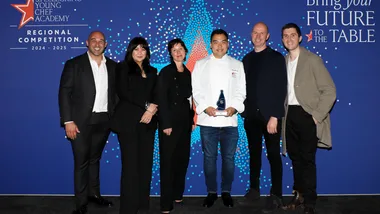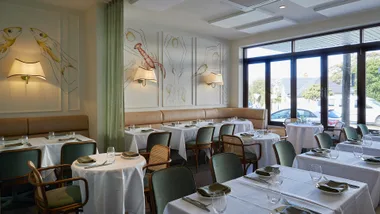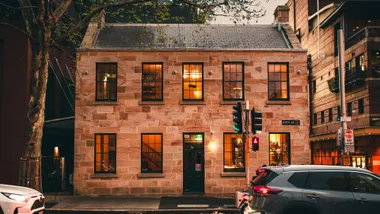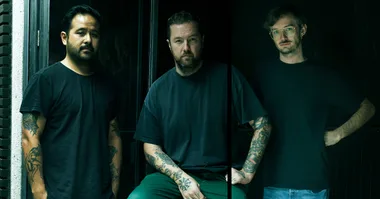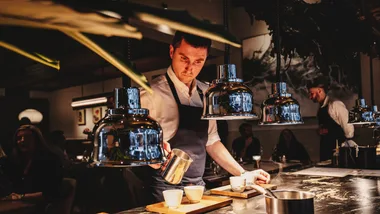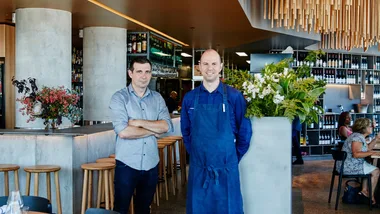People doing big things usually start small. From a Tasmanian wasabi grower to a family-run beehive farm, we talk to Australian farmers and makers about the dreams behind their dream businesses.

Emily Yarra at Brightside Produce
(Photo: Lean Timms)Emily Yarra & Michael Kobier | Brightside Produce, Anembo, NSW
“We just wanted to live out in the bush,” says Michael Kobier, half the duo that runs Brightside Produce. For Emily Yarra, Kobier’s partner in life and business, the progression to full-time work from law school didn’t excite her. The couple lived in Canberra at the time and dreamed of moving to the country and avoiding the city commute. “[But] we weren’t sure how that looked in a practical sense,” says Yarra.
Six years of WWOOFing (working on organic farms) in North America and Europe, labouring on commercial farms in Australia, reading, taking courses and dreaming gave them the answer: Brightside Produce, a chemical-free, organic farm in Anembo, 90 minutes’ drive south-east of Canberra. “We moved out here in July 2015, planted in October and were selling by December,” says Yarra.

Happy hens at Brightside Produce.
(Photo: Lean Timms)They started by supplying friends and family with boxes of produce harvested that week. These days they grow between 15 and 30 varieties of heirloom vegetables at any time, supplying 25 produce-box subscribers (there’s more on a waiting list) and a range of Canberra restaurants and cafés, including Bar Rochford and Pilot. “We grow a certain range of vegetables because our soil needs the diversity to stay healthy,” says Yarra. “Subscribers get eight to 12 different seasonal vegies, changing each week.” These, and the chefs’ picks of what’s available, are driven to Canberra the day of harvest.
Unpredictable weather patterns and changes in climate don’t make this line of work easy. “We’d like to move into more perennial produce, like odd fruits and rare berries – we’re keen to become more adventurous,” says Yarra. “We’re always dipping our toes into more specialty stuff.”

Ralf Fink, Oakwood Smallgoods Co, Castlemaine, Vic
(Photo: Richard Cornish)Ralf Fink | Oakwood Smallgoods Co, Castlemaine, Vic
With a bag full of butcher’s knives and his dog, Ralf Fink landed in Melbourne unknown. A German fleischmeister, or master butcher, he had left Germany for South Dakota after the GFC. Despite eight years of solid training under his leather apron, his skills were not respected in small-town USA where jerky and baloney were the closest thing to charcuterie. Dejected, he searched for somewhere his skills would be recognised.
In Melbourne he worked with top butchers making salumi, and was on big bucks working for manufacturers when he saw a 19th-century mill that had been converted to an artisan food hub in Castlemaine. “I had trained to be a fleischmeister since I was 16. Just like my father,” he says. “I knew I had to return to my trade.” And so he returned to hand-making smoked bacon, ham, weisswurst, blutwurst, leberkase and frankfurts using traditional recipes.
Less than two years back at the smoker, he has teamed up with local pig farmers who raise heritage Large Blacks. Fink is most proud of his jamón, made from pigs fed on acorns from an oak forest nearby. “What I need are young butchers to follow in my footsteps,” he says. “I have built the butchery and smokehouse. They will come.”

Wasabi plants at Shima Wasabi.
(Photo: Shima Wasabi)Esme Atkinson | Shima Wasabi, Tas
“It’s a challenge to keep them happy,” says Esme Atkinson of the 10,000 wasabi plants she and her colleagues coax into maturity in greenhouses at the Shima Wasabi farm in Tasmania’s north-west. In fact, the team refer to the root vegetable as a “moody teenager” because of its fickleness; it hates being exposed to too much heat or light.

Freshly grated wasabi.
(Photo: Shima Wasabi)But Atkinson has worked with the plant for long enough now to know what will keep it from turning up its toes. She started at Shima as a harvester before taking over from founder Stephen Welsh in 2017. The company sells about 20 kilograms a week of fresh wasabi across Australia. But the hard work doesn’t stop there. “One of the biggest challenges we have is educating people about what wasabi actually is,” she says. “There’s a perception that wasabi will blow your head off. True wasabi is hot but it’s subtle, with a sweet and almost delicate flavour.” Atkinson suggests trying it with something other than the usual sushi. “I love it with a beautiful steak,” she says. It’s as versatile on the table as it is temperamental in the ground.

A fresh catch.
(Photo: Chris Bolton Fishing)Chris Bolton | Chris Bolton Fishing, QLD
“All I ever wanted to do was to go fishing,” says Chris Bolton. And that’s just what he did, but it soon became clear that to earn a living long-term, he’d need to do things differently. While supplying wholesalers in Cairns, he realised that trying to catch as much as possible wasn’t sustainable. “Fish are a limited resource. I realised the only option was to get more money for a higher quality product.”
Bolton saw the demand for fresher fish, handled and sourced with care. With that in mind, he kitted out his boat to keep his catch in the best state possible. “The fish are line-caught then killed using ike-jime, a Japanese process that uses a spike to go through the fish’s brain, killing it instantly,” he says. “The fish are then plunged into ice-cold salted water to prevent them from swelling.”
Bolton supplies more than 50 top Australian restaurants, including Jonah’s and Ester, with wild-caught reef fish such as red emperor and coral trout. Bolton and one other crew member catch about 20 tonnes of fish a year, and he inspects each and every one. “The biggest challenge is educating people on just how sustainable fishing can be so we don’t get shut down,” he says.
Andrew Wyszynski | Maya Sunny Honey, Mudgee, NSW

Andrew Wyszynski and his bees.
(Photo: Pablo Martin)For Andrew Wyszynski, life was always about bees. His lifelong love affair started during childhood on a farm in Okonek, north-west Poland, with beekeeper parents who rose at dawn to check the queen and brood. “I was fascinated at how bees work together in light and darkness, how they communicate with each other,” Wyszynski says. He went on to study at apiarist school and later lectured on queen bee production and worked as a beekeeper.
When given the chance to work with beekeeping supplier Browns Bees Australia, he migrated with his wife Regina and their young daughter. “In Poland, the season is only three to four months long because of the cold winters,” he says. “Australia has a great climate for bees with a year-round season.”
Wyszynski, Regina and their daughters, Joanna and Maya, run the family business, Maya Sunny Honey. They have 150 beehives on their farm in Mudgee, each hive housing about 40,000 bees. “I fell in love with the local landscape, the rolling hills and the native bees,” he says. “Our honey captures pure nature Down Under.”

Jars of Maya Sunny Honey.
(Photo: Pablo Martin)Hives are positioned beside blossoming natives including wattle, orange gum and ironbark, and the honey is collected using a unique technique: glass jars are placed upside-down on top of the hives,
and about 500 bees enter each jar to create honeycomb inside.
Wyszynski believes honey is “a superfood that everyone should have in their kitchen”, helping to reduce inflammation, improve digestion and boost immunity. “As Einstein said: ‘If the bee disappeared, man would only have four years left to live.'” No bees, no life

Cambray Cheese wheels in the cave.
(Photo: Elements Margaret River)Tom Wilde | Cambray Cheese, Cundinup, WA
Tom Wilde describes himself as a full-time cheesemaker and a part-time rally driver. When he’s not on the race track he’s at Cambray Cheese, a farm-to-platter business that his parents, Bruce and Jane, run in Cundinup, three hours south of Perth.
He began pitching in when he was a schoolkid and eventually helped his father build the factory. Now he works in the family business, milking 280 ewes and making cheese.
Much of his time is spent in the temperature-controlled cave where cheeses are left to mature. Each wheel weighs between 15 and 200 kilograms, and they need to be turned as part of the ageing process. “It’s definitely quite a work-out doing the whole room,” he says.
Fresh curds are ready to go at just three days, but mature sheep’s milk cheeses can take years to age. “We just cut into a cheese that was made back in 2013,” says Wilde, who compares the approach to making wine.
Cambray’s Farmhouse Gold and two cow’s-milk cheeses, Blackwood Blue and Cumin Gouda from milk produced nearby at Walsall Dairy, all picked up gold at the WA Dairy Industry Association Awards. It’s the culmination of a long process that includes prepping ryegrass-clover hay for the sheep and breeding the animals on Valentine’s Day each year.
Sure, Curtis Stone, Nigella Lawson and Peter Kuruvita are well aware of Cambray Cheese, but recognition isn’t what drives Wilde – it’s knowing another wheel is ready. “I’m extremely proud to see a product start out as grass in a paddock and end up as an 18-month-old mature sheep’s milk cheese.”

Monique Millton and Tim Webber of Manon Wine, with their son, Felix
(Photo: Tyrone Ormsby)Monique Millton & Tim Webber | Manon Wine, Adelaide Hills, SA
While foraging for saffron milk cap and grey ghost mushrooms in South Australia’s Adelaide Hills, vegetable growers Tim Webber and Monique Millton came across vineyards that weren’t being cultivated.
They negotiated with farmers for the grapes and, in 2015, produced a collection of Manon Wild Nature wines, made predominantly with fruit from abandoned vineyards.
The wines caught the attention of Noma sommelier Mads Kleppe and went straight on the Noma Australia list. “That really changed things for us,” says Millton.
Webber is a former Sean’s Panaroma chef and was half of the team that opened Sydney wine bar Love, Tilly Devine. He has long been an advocate for natural wine; so, too, his partner Millton – her parents planted New Zealand’s first biodynamic wine estate, Millton Vineyards, in the ’80s. “It’s a very unique thing to do, to make wine from the grapes that you grow,” she says. “It was the only way we wanted to do it long-term.”
In 2016, the couple bought 10 hectares high on Forest Range, the ridge above Basket Range, and dubbed it Manon Farm. They tend 13 parcels with more than 10 grape varieties. These produce everything from single-parcel wines to Cosmic, a blend of all the varieties on the farm.
Machinery and chemicals, you won’t find. Just organic grapes, pruned and picked by hand, and left to ferment in the tractor shed. Homemade treatments made from fermented seaweed and herbs, meanwhile, help to condition the soil, a mineral-rich mix of red clay, quartz and schist. “We’re making living wines,” says Webber. “So we choose to farm with life.”
Three wines were released in May from the 2018 harvest, including a lively Forest Red of half pinot-gris, half pinot-noir juice. “We never put any expectations on our wines,” says Millton. “Experiment, experiment and experiment again,” adds Webber, “until you develop your own dialogue with nature.”

The Dairyman, Michael Wohlstadt, with his cows.
(Photo: Max Veenhuyzen)Michael Wohlstadt | The Dairyman, Barossa Valley, SA
Every day after school the 12-year-old Michael Wohlstadt would find his way across the road to his neighbour’s dairy farm in the Barossa Valley, where he’d help with their herd of gentle Jersey cows until the sun set. “They became like my second family,” he says.
His actual family, who migrated from Germany after World War II, hoped this youthful interest in farming would stop there. “My grandfather used to tear out articles about how hard agriculture was, and things about finance being a good career path,” he says with a laugh. Their efforts were in vain. “I bought this farm when I was 23 and I’ve been here for nearly 40 years.”
The Jersey cows were the first thing he brought on board, an homage to the herd from his childhood that he loved so much (“Choosing a cow is a bit like choosing a football team,” he says. “It’s what I knew and I stuck with it.”). Cream is pasteurised on Mondays, and Wednesdays are spent churning butter, which is sold at the farm gate, local markets, specialist storesand local restaurants. Then there are the free-range heritage pigs – Berkshires, Hampshires and Tamworths – which are fed on milk from the cows mixed with grain grown on the property, and sold as fresh meat, mostly to restaurants, or as sausages and cold cuts.
Wohlstadt is entirely hands-on. He loves the sights and smells of the farmyard every bit as much as he did when he was 12. “It’s a very enjoyable way to live.”

